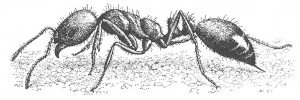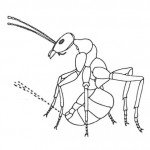
Approx. 100 million years ago, Ants (Formicidae) evolved from small solitary wasp-like ancestors. Some ants still have an actual venomous stinger like wasps. These stinging ants may attack if you accidentally sit on an anthill.

There is usually no doubt about what the problem is. An anthill in the lawn can be eradicated by saturating the hill with a diazinon solution. The ants which occasionally turn up inside the house, the black garden ants have no stingers. They do, however, have venom glands from which they can spray the venom. The venom mainly consists of formic acid, but the black garden ants do not attack people.
The big red wood ants (Formica rufa), on the other hand, do attack humans because they attempt to bite a whole in the skin while spraying the venom.

The wood ants are useful animals, which kill harmful insects, but a large anthill in the immediate vicinity of the house can be troublesome. If you want to save the wood ant colony, you can scoop the anthill into a tarpaulin and place it in a suitable location in the woods. Alternatively, you can coat the anthill {1with insect powder.
Pharaoh ant, Monomorium pharaonis is a quite small, only 2 mm long, light yellowish ant. It is originally a tropical ant, and in Denmark, it is entirely dependent on heated buildings. The Pharaoh ant can be troublesome in private households, where it seeks out foods. These tiny ants will seek out wounds, if the opportunity presents itself, and it can be affect bedridden people.
Pharaoh ants crawl under bandages and plaster casts where they can cause itching and other discomfort. They are frequently seen in hospitals. Control is difficult and usually requires professional assistance




